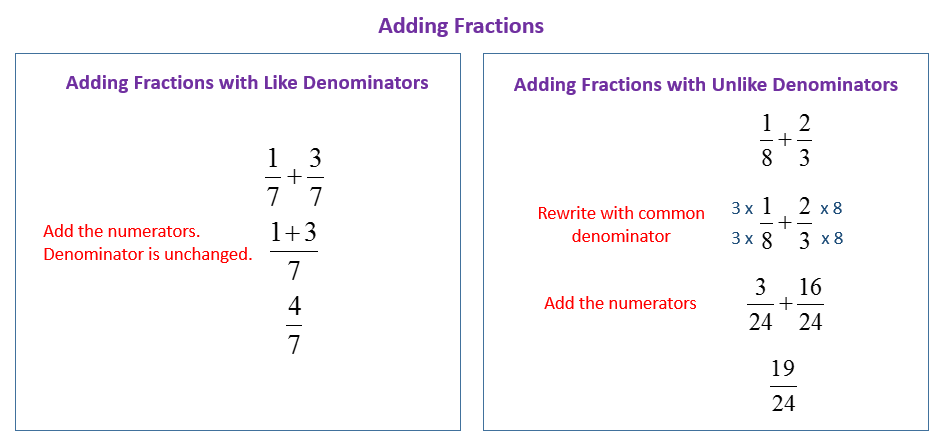
# Step 3: Add the equivalent fractions that is 5/10 + 6/10 = 11/10.

# Step 2: To find equivalent fractions of 1/2 and 3/5 with denominator 10, multiply the numerator and the denominator of 1/2 by 5 and, multiply the numerator and denominator of 3/5 by 2. # Step 1: The least common multiple of denominators that is 2 and 5 is 10. Look at the solved examples given below and analyse the steps in which the problem is resolved. Hence the sum of fractions is calculated. # Step 3: Keeping the denominators constant add the numerators of the like terms. Repeat the same for all the, unlike terms. # Step 2: Multiple the numerator and the denominator of the unlike term so that the denominator is equivalent to the least common multiple.

# Step 1: Find the least common multiple of all the denominators of the unlike terms. Here is a step by step procedure to add fractions with different denominators.įirstly we need to convert, unlike fractions into like fractions.
Adding fractions with unlike denominators how to#
So, therefore, 6/12 and 4/12 are like fractions with the same denominators.Īlso Read: How to Make a Math Game for Kids? A Complete Guide to Make Your Kid Shine in Maths Addition of Unlike Fractions Multiply the numerator and denominator of 2/4 by 3, and multiply the numerator and denominator of 1/3 by 4. Now, we need to find fractions equivalent to 2/4 and 1/3 which have 12 in the denominator. To convert an unlike fraction into a like fraction we have to consider the least common multiple of the denominators then finds the equivalent fractions by multiplying them to get the L.C.M as the denominator.įor example, 2/4 and 1/3 are unlike fractions, here the least common multiple of 4 and 3 is 12. How to Convert Like Fractions into Unlike Fractions? They need to convert into like fractions before adding.Įxamples: (1/2, 3/4, 1/5) and (3/6, 2/7, 5/8). Unlike Fractionsįractions with different numerators and different denominators are called, Unlike Fractions.

Like Fractionsįractions with different numerators and the same denominators are called Like Fractions. In mathematical form, it is written as 4/8, with 4 as the numerator above the dividing line and 8 as the denominator below the dividing line. As you’re not sure about the taste of your chocolate cake, you decided to share 4 pieces of it with your friend to know how it is made.

The denominator: the lower part of the fraction, the number below the dividing line.Īnd the Dividing line: It is the small line that separates the numerator and the denominator.įor example, there are 8 pieces of your favourite chocolate cake you made. The numerator: the upper part of the fraction, the number above the dividing line. The portions may even be composing their numbers, but altogether they construct a whole picture. Therefore, children must be able to acknowledge the idea of it completely and carry out the same when the time comes.įractions explained are nothing but portions of a sum, used to represent the smaller parts of a greater thing. It is also one of the important skills in advanced mathematics. The trouble arises when the fractions are of different denominators because we require the same denominators for adding.īefore starting with the inner topic we need to understand what is a fraction, a like and unlike fraction and how to convert an, unlike fraction into a like fraction.Īlso Read: Vedic Maths Tricks for Kids: An Innovative Way of Learning Mathematics What is a Fraction for Kids?įraction for kids is trying to explain how to work fundamental math with its support. Adding with the same denominators is not a difficult task. Let us consider some of the examples of adding unlike fractions:ġ.While adding fractions the numerators are added and the denominator remains constant.


 0 kommentar(er)
0 kommentar(er)
